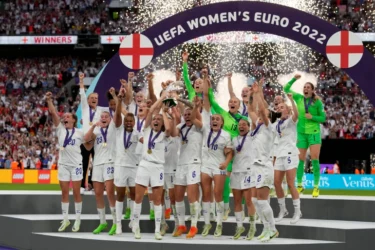As England take home the win at the Women’s Euros 2022, Senior Account Director Leonie Strak examines what happens next, and why brand support is essential for women’s sport to thrive.
The 2022 Women’s Euros has propelled women’s football back into the spotlight. Tickets were purchased in 99 countries, with 20 per cent of attendees coming from overseas. There were 13 official brand partners, and we’ve seen lots of fantastic activations and partnerships that are increasing the visibility of the game.
All sounds pretty positive. But what happens now the final whistle has been blown? Inevitably, the majority of these brands will move on, never to be seen again till the next headline-making international tournament. With the World Cup just around the corner, there’s a real risk that women’s football will be kicked to the sidelines. It’s this lack of consistency that threatens to hold back women’s sport from going mainstream.
Brands have the power and the responsibility to support women’s sport; exposure and alliance are central to both perception and popularity. So how can we, as marketers, support women’s sport beyond headline-grabbing tournaments?
Put your money where your mouth is
Brands, particularly those that resonate with young girls, need to be investing in all levels of the sport, all year round, from grassroots right up to league tournaments and beyond. This will inevitably strengthen the perception and growth of women’s sport over time, with brands shining the light on all levels of achievement.
Barclays has made the largest ever commercial investment in women’s sport in the UK, committing themselves to give girls in England equal access to football in schools by 2024. They’ve also developed a programme in partnership with the Youth Sport Trust that is delivered in secondary schools across England, using football as the tool to develop and teach key life skills to young girls. This brand support is forward-thinking, inspiring and teaching the next generation to become invested in women’s sport.
By setting themselves a target, Barclays is holding themselves accountable, committing themselves to support women’s sport well beyond major tournaments. The amount of money that is being invested into women’s football is outrageously low in comparison to the men’s game; the winners of the Women’s World Cup will receive just $4m compared to $38m for the men. It’s time for brands to step up and cough up, with investment in grassroots football clubs essential in securing the successful future of the game and its players.
Allyship is the answer
It’s without question that male sports stars, from commentators and pundits to players, hold huge influence over their audience. That’s why it’s essential that they must shout louder for equality using their platforms and profiles to help speed up change.
Ian Wright has been vocal in his support for women’s football, calling for matches at major stadiums (most of the Euro’s games are at comparatively smaller venues). As an FA Women’s Super League Ambassador, Wright often tweets messages of support and excitement about the game to his 2.1million followers. As a well-respected athlete, this passionate commentary and allyship is paramount to changing the perception of women’s football, encouraging his audience to get involved and take the sport as seriously as its men’s equivalent.
Grace Vella, founder of the female-friendly sportswear business Miss Kick, highlights the need for male allyship, saying men can also “play a big part” by helping to promote Miss Kick on their social media accounts, saying “we’re trying to find male advocates because, as sad as it sounds, they are the ones with the huge following.”
Inequality is real and it needs to be addressed. Heineken’s ‘I Am The 12th Woman’ campaign has incited a conversation about the entrenched bias and inequality that persists across football culture. The film features football icons Harry Redknapp and Jermaine Jenas wearing the t-shirts adorned with the ‘12th woman’ slogan, highlighting their allyship and commitment to breaking down gender bias both on and off the pitch.
This issue is not a once-a-year topic. Brands can shine a light on this inequality all year round, and during male tournaments too. Whilst it’s powerful to promote this message during Women’s Euros 2022, it’d arguably hold more gravitas if showcased outside of a major tournament.
Community is key
Without community, sports wouldn’t have half the impact it does. By harnessing the passion within communities for team sports, brands and organisations can help propel women’s football to the next level and a permanent fixture in the public’s consciousness.
adidas London recognised that women’s teams often find it difficult to book pitches, due to more established men’s teams making repeat bookings. They’re offering a hand, providing a WhatsApp number that’ll help women’s teams find a pitch to play on. This is offering direct community support, acknowledging an issue and providing a solution to resolve it, ultimately helping boost women’s football to the next level.
Women’s sport isn’t going anywhere, but if it is to enjoy a future as bright as it deserves, it needs support, from brands, allies and community. So if you’re looking for the perfect time to get involved, that time is now.
This article was originally published on FC Business.
